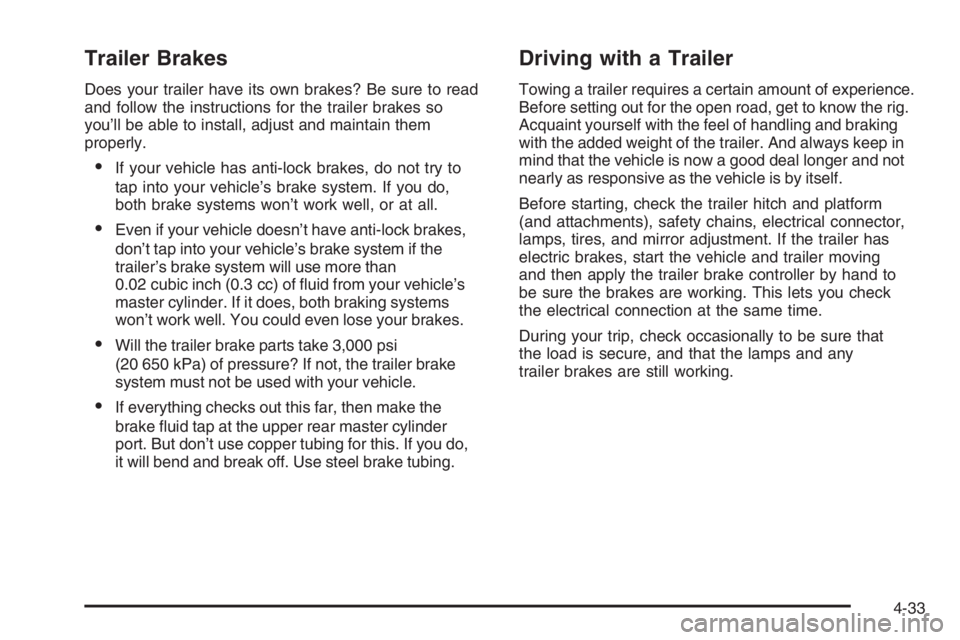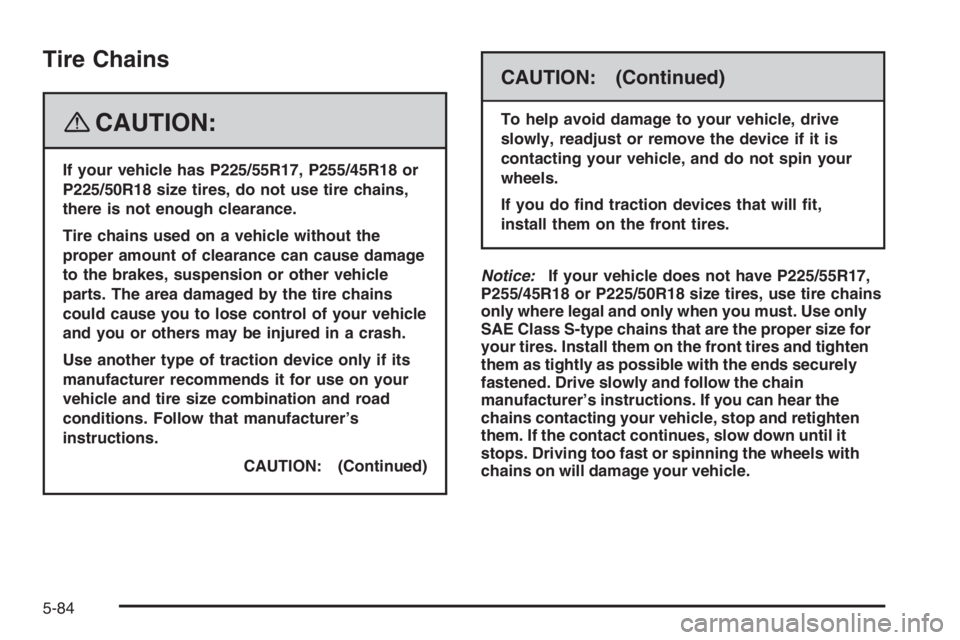Page 267 of 450

Trailer Brakes
Does your trailer have its own brakes? Be sure to read
and follow the instructions for the trailer brakes so
you’ll be able to install, adjust and maintain them
properly.
If your vehicle has anti-lock brakes, do not try to
tap into your vehicle’s brake system. If you do,
both brake systems won’t work well, or at all.
Even if your vehicle doesn’t have anti-lock brakes,
don’t tap into your vehicle’s brake system if the
trailer’s brake system will use more than
0.02 cubic inch (0.3 cc) of �uid from your vehicle’s
master cylinder. If it does, both braking systems
won’t work well. You could even lose your brakes.
Will the trailer brake parts take 3,000 psi
(20 650 kPa) of pressure? If not, the trailer brake
system must not be used with your vehicle.
If everything checks out this far, then make the
brake �uid tap at the upper rear master cylinder
port. But don’t use copper tubing for this. If you do,
it will bend and break off. Use steel brake tubing.
Driving with a Trailer
Towing a trailer requires a certain amount of experience.
Before setting out for the open road, get to know the rig.
Acquaint yourself with the feel of handling and braking
with the added weight of the trailer. And always keep in
mind that the vehicle is now a good deal longer and not
nearly as responsive as the vehicle is by itself.
Before starting, check the trailer hitch and platform
(and attachments), safety chains, electrical connector,
lamps, tires, and mirror adjustment. If the trailer has
electric brakes, start the vehicle and trailer moving
and then apply the trailer brake controller by hand to
be sure the brakes are working. This lets you check
the electrical connection at the same time.
During your trip, check occasionally to be sure that
the load is secure, and that the lamps and any
trailer brakes are still working.
4-33
Page 297 of 450
{CAUTION:
You can be burned if you spill coolant on hot
engine parts. Coolant contains ethylene glycol,
and it will burn if the engine parts are hot
enough. Do not spill coolant on a hot engine.
Occasionally check the coolant level in the radiator. For
information on how to add coolant to the radiator,
seeCooling System on page 5-30.
Pressure Cap
Notice:If the pressure cap is not tightly installed,
coolant loss and possible engine damage may
occur. Be sure the cap is properly and tightly
secured.
SeeEngine Compartment Overview on page 5-12for
more information on location.
Engine Overheating
There is a coolant temperature gage and a warning light
on the instrument panel that indicate an overheated
engine condition. SeeEngine Coolant Temperature
Gage on page 3-49andEngine Coolant Temperature
Warning Light on page 3-48.
5-27
Page 326 of 450
A. High-Beam Headlamp
B. Low-Beam Headlamp
C. Sidemarker Lamp
5. Turn the bulb socket ring one-quarter of a turn
counterclockwise to remove it from the headlamp
assembly.6. Pull the old bulb from the socket.
7. Place the new bulb into the socket.
8. Turn the bulb socket ring one-quarter turn clockwise
to reinstall it back into the headlamp assembly.
9. Carefully reinstall the headlamp assembly.
10. Push down on the metal retaining clip while pushing
rearward on the headlamp, making sure the
headlamp assembly is secure.
11. Reinstall the bolt and tighten to secure.
5-56
Page 327 of 450

Front Turn Signal, Parking and Fog
Lamps
The front turn signal, parking, and fog lamps, if the
vehicle has them, are located below the headlamp
assembly.
A. Front Turn Signal/Parking Lamp
B. Fog Lamp (If Equipped)
To replace one of these bulbs, do the following:
1. Follow Steps 1 through 4 of the headlamp
replacement procedure. SeeHeadlamps and
Sidemarker Lamps on page 5-54for more
information.2. Locate the front turn
signal/parking lamp (all
models) and fog lamp
bulbs (if equipped),
which are located below
the headlamp
assembly.
The arrow indicates which is the turn signal/parking
lamp bulb. The fog lamp bulb is below it, if your
vehicle has this bulb. If you need to have fog lamp
bulb replaced, see your dealer/retailer for service.
3. Turn the bulb socket one-quarter of a turn
counterclockwise to remove it from its assembly.
4. Pull the old bulb from the socket and replace it with
a new one.
5. Turn the bulb socket a quarter turn clockwise to
reinstall it.
6. Reinstall the headlamp assembly.
7. Push down on the metal retaining clip while pushing
rearward on the headlamp, making sure the
headlamp assembly is secure.
8. Reinstall the bolt and tighten to secure.
5-57
Page 354 of 450

Tire Chains
{CAUTION:
If your vehicle has P225/55R17, P255/45R18 or
P225/50R18 size tires, do not use tire chains,
there is not enough clearance.
Tire chains used on a vehicle without the
proper amount of clearance can cause damage
to the brakes, suspension or other vehicle
parts. The area damaged by the tire chains
could cause you to lose control of your vehicle
and you or others may be injured in a crash.
Use another type of traction device only if its
manufacturer recommends it for use on your
vehicle and tire size combination and road
conditions. Follow that manufacturer’s
instructions.
CAUTION: (Continued)
CAUTION: (Continued)
To help avoid damage to your vehicle, drive
slowly, readjust or remove the device if it is
contacting your vehicle, and do not spin your
wheels.
If you do �nd traction devices that will �t,
install them on the front tires.
Notice:If your vehicle does not have P225/55R17,
P255/45R18 or P225/50R18 size tires, use tire chains
only where legal and only when you must. Use only
SAE Class S-type chains that are the proper size for
your tires. Install them on the front tires and tighten
them as tightly as possible with the ends securely
fastened. Drive slowly and follow the chain
manufacturer’s instructions. If you can hear the
chains contacting your vehicle, stop and retighten
them. If the contact continues, slow down until it
stops. Driving too fast or spinning the wheels with
chains on will damage your vehicle.
5-84
Page 363 of 450
19. Dispose of the sealant canister at your
dealer/retailer or in accordance with your local state
codes and practices.
After using the sealant canister, replace it with a
new canister from your dealer/retailer.
20. After temporarily repairing a tire with the emergency
�at tire repair kit, take your vehicle to your
dealer/retailer to have the tire inspected and
repaired.
Using the Air Compressor without
Sealant
To use the air compressor by itself to in�ate a tire:
1. Remove the air compressor accessory plug from
the air compressor. 2. Unlock the air compressor hose from the sealant
canister by pulling up on the lever.
3. Pull the air compressor in�ator hose from the
sealant canister.
4. Push the air compressor in�ator hose onto the tire
valve stem and push the lever down to secure
in place.
5-93
Page 377 of 450

Storing a Flat or Spare Tire and
Tools
{CAUTION:
Storing a jack, a tire, or other equipment in the
passenger compartment of the vehicle could
cause injury. In a sudden stop or collision,
loose equipment could strike someone.
Store all these in the proper place.
After the compact spare tire is put on the vehicle, store
the �at tire in the trunk. Use the following procedure
to secure it in the trunk. When storing a full-size tire, use
the extension and protector/guide, located in the foam
holder, to help avoid wheel surface damage.To store a full-size tire:
1. Install the tools in their original location in the trunk
area and secure.
2. Place the tire in the trunk with the valve stem facing
down, and the protector/guide placed through a
wheel bolt hole.
3. Remove the protector and attach the retainer
securely.
4. Place the protector/guide back in the foam holder
when putting the compact spare back in the trunk.
Store the cover as far forward as possible.
The compact spare tire is for temporary use only.
Replace the compact spare tire with a full-size tire as
soon as possible. SeeCompact Spare Tire on
page 5-109for more information. Use the following as a
guide for storing the compact spare tire and tools.
5-107
Page 409 of 450

Engine Coolant Level Check
Check the engine coolant level and add DEX-COOL®
coolant mixture if necessary. SeeEngine Coolant
on page 5-24.
Windshield Washer Fluid Level Check
Check the windshield washer �uid level in the windshield
washer �uid reservoir and add the proper �uid if
necessary.
At Least Once a Month
Tire In�ation Check
Inspect your vehicle’s tires and make sure they are
in�ated to the correct pressures. Do not forget to
check the spare tire. SeeInflation - Tire Pressure on
page 5-69. Check to make sure the spare tire is stored
securely. SeeChanging a Flat Tire on page 5-96.
Tire Wear Inspection
Tire rotation may be required for high mileage highway
drivers prior to the Engine Oil Life System service
noti�cation. Check the tires for wear and, if necessary,
rotate the tires. SeeTire Inspection and Rotation
on page 5-75.
At Least Once a Year
Starter Switch Check
{CAUTION:
When you are doing this inspection, the
vehicle could move suddenly. If the vehicle
moves, you or others could be injured.
1. Before you start, be sure you have enough room
around the vehicle.
2. Firmly apply both the parking brake and the regular
brake. SeeParking Brake on page 2-33.
Do not use the accelerator pedal, and be ready to
turn off the engine immediately if it starts.
3. Try to start the engine in each gear. The vehicle
should start only in PARK (P) or NEUTRAL (N).
If the vehicle starts in any other position, contact
your dealer/retailer for service.
6-9